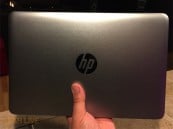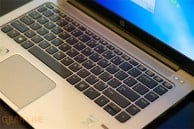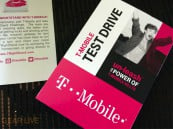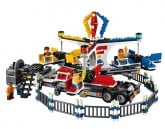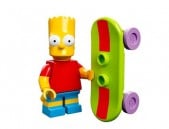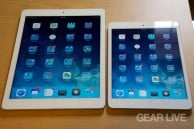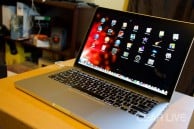Bleeding Edge TV 162: Special Edition Engraved AMD Chip Awarded to Vanishing Point Winner

Posted by Andru Edwards Categories: Gizmatic, Short Bytes, Announcements, Corporate News, Features, PC / Laptop, Videocasts,
So if you have been a follower of
The Bleeding Edge for any length of time, you know that we have been following the Vanishing Point game since it started, courtesy of Windows Vista and AMD. One of the puzzles was the LOKI meta-puzzle, where the first person to figure out exactly who Loki was would win a prize. The prize turned out to be a special run of AMD processors that would be engraved with your name, or phrasing of your choice. Audrey Murphy was the first to solve the puzzle, and we were on hand when she was awarded one of her special edition chips.
Here's how to get the show:|Download| - iPod-formatted H.264
|Download| - Apple TV High Resolution
|Download| - MPEG-4
Advertisement
Bleeding Edge TV Goes Behind The Scenes at AMD

Posted by Andru Edwards Categories: Gizmatic, Short Bytes, Corporate News, Features, Home Entertainment, PC / Laptop, Software, Videocasts,
We went down to AMD headquarters in Austin, TX to take a look behind the scenes at AMD. The chipmaker gave us access to just about anything and everything, and the result is a series of videos that just might change the way you think about the company that grew to give Intel a run for it’s money. Here is a list of the content you will see appear over the next few days:
- Inside the AMD Performance Lab
- Winner of Vanishing Point Meta-Puzzle Awarded Plaque
- The Difference Between AMD and Intel Approaches to Quad Core Processing
- Head to Head: Intel Chipset vs. AMD Chipset In-Game Performance
- AMD Live! Digital Home Cinema
Plus we have a few things that we can’t even show you for another week or so, but we are sure that you will enjoy everything we have put together in this series of videos. As pieces are published, we will linkify the above video descriptions so they are easy to find.
Here's how to get the show:|Download| - iPod-formatted H.264
|Download| - Apple TV High Resolution
|Download| - MPEG-4
Bleeding Edge TV 161: Bluetooth SIG Gives Us Bluetooth 2.1 + EDR Demo

Posted by Andru Edwards Categories: Gizmatic, Short Bytes, Cell Phones, Corporate News, Features, PC / Laptop, Peripherals, Software, Videocasts, Wireless / WiFi,
Bluetooth SIG just announced the new spec for Bluetooth, that being Bluetooth 2.1+EDR. We had Mike Foley head on over to Gear Live headquarters to give us a first look at what is improved in the new spec, and to show off the ultra-cool near field communication technology that is now a part of Bluetooth. If that isn’t cool enough, we can also expect up to 5x better battery life out of our Bluetooth devices as well, as it pertains to Bluetooth battery drain. Check the video for all the details.
Here's how to get the show:|Download| - iPod-formatted H.264
|Download| - Apple TV High Resolution
|Download| - MPEG-4
Bleeding Edge TV 159: AMD 690 Press Conference Q&A

Posted by Andru Edwards Categories: Gizmatic, Short Bytes, Corporate News, Design, Features, PC / Laptop, Videocasts, Wireless / WiFi,
Following the press conference where AMD formally introduced us to the 690 chipset, was a fairly lengthy Q&A session, which we captured in it’s entirety. Check out the video for the full, unedited version - or check out our summarized notes after the jump.
Someone asked about wattage per teraflop. In the demo we saw, about 200 watts per chip. They are working to develop a standard for wattage per teraflop. Talking about power consumption, going forward they can focus on power-down throughout the platform as opposed to just on the chip or cores themselves.
Question about doing things about what AMD and ATI can do now that they couldn’t do as separate companies. Why the merger?
The 690 was architected in a combined environment. With a tighter cooperation with the R&D teams, you find a level of integration between the chips now. Power management is going to be better, partitioning across the HT bus. In late 2007, you will start seeing exactly what is being talked about. Fantastic batter life in a notebook for example, and in 2009, Fusion. That is what it’s all about, getting everything on the same piece of silicon.
Benchmark of R600, looks to be 260 watts. Can anything be done to bring that down as time goes on? That is fairly high consumption.
With the next version of the R600-based cards, you will see power go down, while performance goes up. Another result of the two companies coming together. Gamers want performance at any cost, and AMD is focused on optimizing dissipation of that thermal energy. 30db noise level coming on multiple CPU and GPU in the near future.
When is the R600 going to hit retail, and what happened?
Moving to 65 nm chips, scheduling was just a bit off. Rather than going with a limited deployment with a single point launch, they chose to delay by a couple of weeks to have a full line launch. It isn’t a silicon problem, it was an internal decision made to allow for a full launch. They will still be available in the first half of 2007.
When will Barcelona systems be available?
Second half of 2007.
Teraflop computing - when is it going to be a reality and not just a demo?
The demo was R600-based. Once the product launches, you will get to see and hear more about that. Second half of this year - XP box, R600 card, Opterons - that will result in teraflop computing. Absolutely this year.
In regards to OLPC, what is the strategy there?
There is something tragic in thinking we are going to teach kids in an emerging country how to use PowerPoint. The goal isn’t to teach kids in Uganda how to use Office 2007, despite how great it is. Take the OLPC and use it for an hour and think about what the implications are. Different strategies lead to different results. OLPCs philosophy is to help kids have access to the world, not to teach them how to use computers. The last time you had a chance for a kid to teach you something, how special was that? It’s okay if the children have these computers and get to teach their teachers something. The approach of the competition doesn’t empower children as much as it empowers teachers. It doesn’t hurt, it’s just a different route. AMD isn’t trying to market to that environment, they are trying to change it. That is evidenced by OLPC being a non-profit organization.
The screen on the OLPC is amazing. Better than any of the screens any of us sitting here has. Can be read in direct, full sunlight. Will last 30 times as long. Very scratch resistant, and consumes less than 2 watts.
Here's how to get the show:|Download| - iPod-formatted H.264
|Download| - Apple TV High Resolution
|Download| - MPEG-4
Bleeding Edge TV 160: All About the OLPC Project, Look at OLPC XO

Posted by Andru Edwards Categories: Gizmatic, Short Bytes, Corporate News, Design, Features, PC / Laptop, Toys, Videocasts, Wireless / WiFi,
We speak with Eric Deritis from AMD as he gives us an overview of the OLPC. The One Laptop Per Child project is an important one, and Eric not only shows us a near-final build of the hardware and software, but he also gives us some background on the project itself, and why it’s impact could be so huge. One quote he gave us was that the product isn’t meant to reach the next billion people in the world, but rather it’s meant to reach the last billion people. Powerful stuff.
Here's how to get the show:|Download| - iPod-formatted H.264
|Download| - Apple TV High Resolution
|Download| - MPEG-4
Bleeding Edge TV 158: AMD Press Conference: 690 Series, R600, 1 Teraflop

Posted by Andru Edwards Categories: Full Episodes, Gizmatic, Corporate News, Design, Features, PC / Laptop, Video Games, Videocasts, Wireless / WiFi,
We were on hand when AMD announced the 690 chipset, and also showed off the new R600 graphics technology, showing how it is able to hit the 1 teraflop mark. The video features the entire press conference presentation, including an update on the status of ATI R600, why it was delayed, and when it will launch. If you want the text version, we took minutes of the conference, which you can read below (also, be sure to check out the AMD press conference Q&A session video):
We are sitting here live at AMD’s press conference this morning, where there should be a few interesting announcements being made. Let’s jump right in, as we are live-blogging it.
10:11: AMD has been too quiet, and they know that. They will no longer allow their competitor to have the talking floor. They will no longer be pushed around by a competitor who doesn’t respect the rules of fair competition. AMD is proud that they are approaching the real issues that the industry is facing. High definition is becoming a reality more and more, and AMD plans to continue to lead that in the PC market. They will be focusing on energy-efficient processing from handhelds to datacenters, the ultimate visual experience, and empowering the world population with affordable Internet access platforms.
10:14: The OLPC initiative started four years ago, but we are now near-launch. There is an almost-final unit here at the conference. The merger of AMD and ATI was a necessary step to take AMD excellence to the next level. AMD says their hope is that their competitors go to the drawing board and beat their chips to spark competition, because AMD is confident that, in the end, their products will beat whatever their competitors respond with. Competition is a good thing.
10:18: Barcelona is more of a killer product than Opteron was when it was launched. Today we are going to get a look at Barcelona. Today AMD will be showing us a lot more than they have in the past. “The new AMD is coming together.”
10:21: Dave Orton hits the stage. This is more than a launch, it’s a campaign for 2007. AMD 690 is the foundation for a compelling PC. The combo here is WIndows Vista, ATI for the visual experience, AMD 690 chipset for stability, AMD Athlon for wide availability and choice. The end result here is great system value. At a platform level, the 690 chipset is the basis for innovation.
10:24: AMD 690 is architected to provide a premium Windows Vista experience. Right now, half the systems tested for Vista compatibility don’t even hit the good level. 75% don’t hit better, and 90% don’t hit best. The goal of the 690 chipset is to put out affordable systems that will be stable and capable enough to provide that Vista experience that Microsoft wants consumers to have, including full high definition capabilities. This includes fully supported Vista drivers.
10:27: The AMD platform strategy happens in phases. In 2007 we are seeing unprecedented support for AMD 690 chipset and boosted performance and power characteristics. In 2008 we will see significant performance enhancement and power-saving improvements, as well as optimized gaming, multimedia, and productivity platforms. Finally, in 2009, that is where we see the real end-goal of the fusion between ATI and AMD. On one chip, CPU, GPU, etc.
10:30: AMD shows off a slide that talks about gaming in Vista and how the AMD 690G Chipset compares with the Intel G965. AMD blows it away in 3DMark05, Aquamark, Half-Life 2, and Far Cry v1.4. Even further, they show a large list of 12 popular games that have vast problems, or that just flat out don’t work, on the Intel G965.
10:33: They are about to do a demo that takes an hour to do on the fastest PC in the world. AMD just did it in about 20 seconds, and that just resulted in 1019 gigaflops, or 1 teraflop. Very impressive. This tech would speed up Folding@Home by about 40 times.
10:39: Addressing Torrenza. AMD is looking to Accelerated Computing. The goal again is to blend CPUs and co-processors together. Eventually, at the silicon level, you will have CPU, GPU, accelerators, etc. With multiple cores, you can integrate everything into a heterogeneous core.
10:41: Mario Rivas takes the stage to talk about the outlook on the CPUs. He starts by talking about the evolution of AMD CPUs, from 1999 to this year when Barcelona launches. Up next is a Quad-Core AMD Opteron. This is a native quad-core with significant CPU core enhancements as well as cache enhancements. Also, dedicated technology for virtual environments.
10:45: It’s not good enough to have four cores in the same architecture. Those cores need to be able to communicate, and that will give AMD a 42% performance gain over Intel.
10:47: Turion CPU is up next, followed by Griffin. We now move to innovation on the desktop. The Agena quad core chip will hit the desktop, which is based on Barcelona. Will eventually allow for 8 cores.
Here's how to get the show:|Download| - iPod-formatted H.264
|Download| - Apple TV High Resolution
|Download| - MPEG-4
Bleeding Edge TV 157: iriver W10 Preview

Posted by Andru Edwards Categories: Gizmatic, Short Bytes, CES, CES 2007, Features, Portable Audio / Video, Videocasts, Wireless / WiFi,
We chat with iriver about their upcoming W10 media player. It’s has WiFi connectivity and has a slightly difference interface than the iriver clix. It also features a touch-screen along with stylus, and built-in speaker. The WiFi allows for some great features, like location monitoring (similar to GPS), which means you can find restaurants, hotels, night clubs, and the like. Wifi positioning also has a few other features, which we go over in the video. The iriver W10 will be available in 2, 4, and 8 gigabyte sizes, and should appear on store shelves by the end of June. No pricing info has been released as of yet.
Here's how to get the show:|Download| - iPod-formatted H.264
|Download| - Apple TV High Resolution
|Download| - MPEG-4
Bleeding Edge TV 156: Samsung K5, K3, T9, and BD-P1200 Details

Posted by Andru Edwards Categories: Gizmatic, Short Bytes, CES, CES 2007, Features, Home Entertainment, Movies, Portable Audio / Video, Videocasts,
We talk to Samsung about their K5, T9, and K3 MP3 players, all of which have a couple of unique features for those looking to get away from the whole iPod thing. We also get a look at their newly updated Blu-Ray player, the BD-P1200. The BD-P1200 will retail for $799. Lastly, we take a look at the new 65 Series LCD, which will probably retail for $2999. It has three HDMI inputs, and much improved image capabilities.
Here's how to get the show:|Download| - iPod-formatted H.264
|Download| - Apple TV High Resolution
|Download| - MPEG-4
Bleeding Edge TV 155: Andru Edwards, Chris Pirillo, Robert Scoble, Steve Broback on Blog Marketing

Posted by Andru Edwards Categories: Full Episodes, Gizmatic, Features, Internet, Videocasts,
We take a break from gadgets in this episode, as we present an impromptu roundtable discussion between some of the major players in the blogging space, focusing on marketing and what major companies need to do to start engaging today’s consumer. With the way information is consumed these days, along with the way our generation consumes media, companies need to approach marketing a bit differently. This video features Andru Edwards, Robert Scoble, Chris Pirillo, and Steve Broback discussing these topics in two parts - first, I talk with Scoble, Pirillo, and Broback one-on-one, and then we bring you the full roundtable.
A big thank you to Chris Aarons of AMD for asking us about this topic, which is what motivated us to get some of our friends together for this dialogue.
Here's how to get the show:|Download| - iPod-formatted H.264
|Download| - Apple TV High Resolution
|Download| - MPEG-4
Bleeding Edge TV 154: HydraBrush Dual-Sided Electric Toothbrush

Posted by Andru Edwards Categories: Gizmatic, Short Bytes, CES, CES 2007, Features, Household, Videocasts,
There are all sorts of high-quality electronic toothbrushes out there. HydraBrush aims to take some of the attention off of the Oral B Professionals and SoniCares of the world by combining 8 microbrushes that you actually bite into. By doing so, you get a full brushing on both sides of your teeth as well as a gum massage. Don’t mind the demo, as we were just as uncomfortable watching it in person as we are sure you are watching from the comfort of your screens. In any event, the HydraBrush is available for $109 USD.
Here's how to get the show:|Download| - iPod-formatted H.264
|Download| - Apple TV High Resolution
|Download| - MPEG-4
Advertisement
© Gear Live Media, LLC. 2007 – User-posted content, unless source is quoted, is licensed under a Creative Commons Public Domain License. Gear Live graphics, logos, designs, page headers, button icons, videos, articles, blogs, forums, scripts and other service names are the trademarks of Gear Live Inc.



